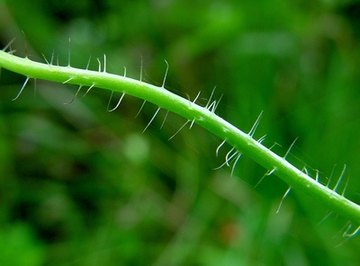
Land plants can be divided into two main groups: bryophytes and tracheophytes. Bryophytes, which evolutionarily precede tracheophytes, are plants that lack true vascular tissues by which to circulate liquids. These plants include mosses, hornworts and liverworts. Tracheophytes, which comprise about 93 percent of all land plants, all possess vascular systems that permit the internal circulation of liquids and nutrients. This group includes everything from flowering plants to trees.
Nutrient, Liquid and Energy Distribution
Most of the advantages of vascular tissues stem from this functional one: A tracheophyte's xylem and phloem--which comprise the vascular system and are housed in the stem--enable liquids, nutrients and energy to be transported and distributed throughout the whole of the plant. Bryophytes depend on diffusion to distribute any acquired liquids, nutrients or energy.
Size
Lack of a vascular system severely limits the size to which bryophytes can grow. Vascularity offers structural support that enables tracheophytes to grow to considerably larger sizes than bryophytes can with their dependence on diffusion. Think, for example, of the diminutive size of mosses as opposed to the height of sunflowers or even trees. The enormous amount of variation in size in tracheophytes allows for a level of resource-competitiveness that bryophytes cannot match.
Variety
The diffusion-based size limitations of bryophytes confine their variation in other respects. The diversity that tracheophytes exhibit in the realms of size, configuration, seed dispersal and habitation gives them an evolutionary leg up. The ability of vascular land plants to produce endless physical variety increases chances of survival and viable propagation in the face of natural selection.
References
About the Author
Ivy Lee has been writing since 2006, and has been published in "Scarlet & Black," The Daily Blank, Strand Books' Rare Books Web site, and helped edit a scientific article recently published in "Developmental Cell." She graduated with a Bachelor of Arts in English from Grinnell College.
Photo Credits
hairy stem image by Josef F Stuefer from Fotolia.com
